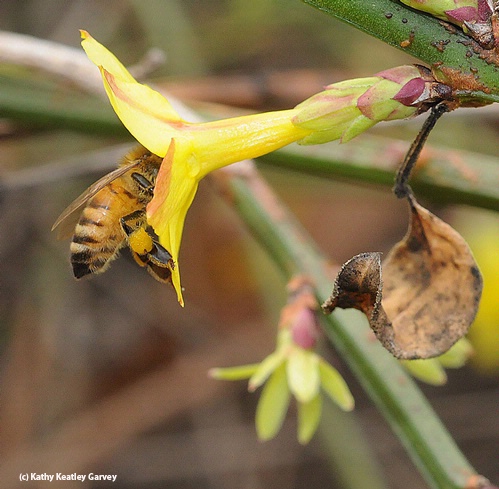- Author: Kathy Keatley Garvey
Saturday, Aug. 17 is National Honey Bee Day and it's time for a tribute, a salute and a cheer, all combined into one: Go, bees!
We're glad to see concerned citizens, organizations and businesses contributing to bee research at the Harry H. Laidlaw Jr. Honey Bee Research Facility, Department of Entomology and Nematology, University of California, Davis.
This year the department was absolutely delighted to receive a $30,000 donation from the California State Society of the Daughters of the American Revolution.
State Regent Debra Jamison adopted the motto, “Bees are at the heart of our existence” and vowed to support research to help the beleaguered bees.
“Every state regent has a fund-raising project; I chose honey bees,” said Jamison, whose first name, Debra, means “bee” in Hebrew. “I have had a lifelong love and respect for bees and I spent a lot of my childhood watching them, attracting them with sugar water, catching and playing with them and even dissecting them during a time when I imagined myself to be a junior scientist.”
“Back in those days, there was an abundance of bees, usually observed by this kid in her family’s backyard full of clover blossoms—something you rarely see any more due to spraying of pre-emergents and other weed killers.”
The funds are earmarked for the lab of bee scientist/assistant professor Brian Johnson. His graduate student, Gerard Smith, researches the effect of pesticide exposure in the field on honey bee foraging behavior, and graduate student Cameron Jasper studies the genetic basis of division of labor in honey bees.
Then just last week Häagen-Dazs, a strong supporter of bee research, and the name behind the Häagen-Dazs Honey Bee Haven at UC Davis, announced it would donate $5 to UC Davis bee research for every download of its Häagen-Dazs Concerto Timer app--up to $75,000.
The way it works, you download the free app at I-Tunes with your I-Phone or I-Pad. You remove your carton of Häagen-Dazs premier ice cream from the freezer and point your I-Phone or I-Pad at the lid. Voila! Two minutes of concerto music, and that's just the right amount of time for your ice cream to soften or temper.
Häagen-Dazs, besides its continuing, generous support of the garden, funded the Häagen-Dazs Postdoctoral Scholar Fellowship to enable virus researcher Michelle Flenniken to study the viruses that plaque honey bees.
Then there's the group of donors that came forth to make the bee garden happen. The garden, located next to the Laidlaw facility on Bee Biology Road, was planted in the fall of 2009 as a year-around food source for the Laidlaw bees and other pollinators, as a way to raise public awareness about the plight of honey bees, and to provide visitors with ideas of what to plant in their own gardens. Donors? You can see their names on the donor page of the Laidlaw facility website. They include the garden designers (Ann F. Baker Donald Sibbett, Jessica Brainard and Chika Kurotaki); landscape contractor Cagwin & Dorward; and Wells Fargo, which funded the bee-utiful bee sculpture in the haven created by Donna Billick of Davis.
Youth worried about the plight of the honey bees came forth to help. Marin County resident Sheridan Miller began supporting bee research at age 11 and continues to do so through various fundraising projects. She's in high school now--and guess what? She's a beekeeper, too.
Periodically, people ask how to donate to UC Davis Bee Research. Just as Häagen-Dazs has an app for that (a concerto timer), the department has a donor page for that. Folks can make their choice(s). This page lists donors who supported the haven at its inception; more names will be added soon. There's also an online donor button on the Laidlaw home page.
Meanwhile, Saturday, Aug. 17 is National Honey Bee Day and a time to make our voices heard. Can't you just hear the queen bees piping?
Go, bees!
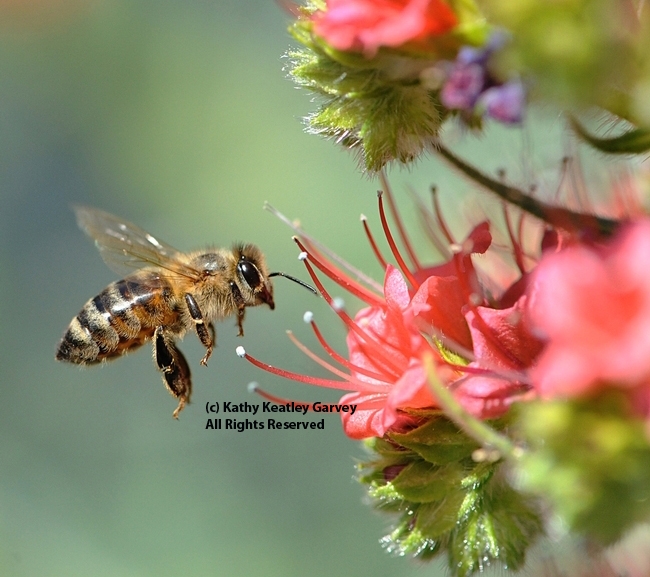

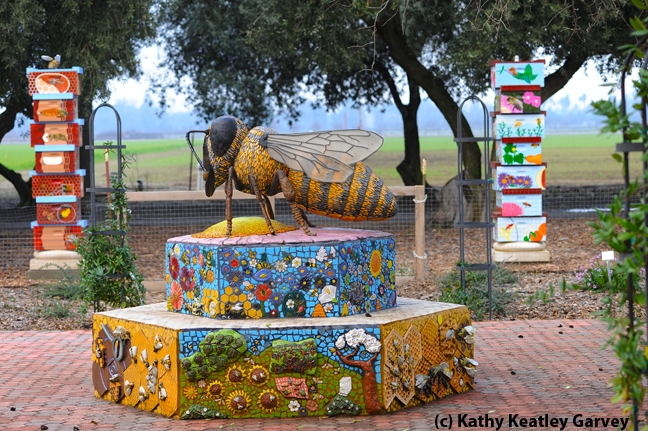
- Author: Kathy Keatley Garvey
Colony collapse disorder (CCD), the mysterious phenomonen characterized by honey bees abandoning their hives, is still with is, and the cause is still mysterious.
Over the past three years beekeepers throughout the United States have reported losing from one-third to 100 percent of their colonies to CCD, says UC Cooperative Extension Apiculturist Eric Mussen, a member of the UC Davis Department of Entomology Faculty since 1976 and a noted authority on honey bees.
The bees just vanish, leaving behind the queen, the immature brood (eggs, larvae and pupae) and stored food.
The calamity of CCD.
The queen, in peak season, lays about 2000 eggs a day. The worker bees serve as the nurse maids, nannies, royal attendants, heating and air conditioning specialists, foragers, guards and undertakers. They feed their mother (the queen) and their brothers, the drones. The sisters are their brothers' keepers. The drones' only function is to mate with the queen.
The worker bees pollinate about 100 crops in California, including nuts, fruits and vegetables. They just finished pollinating California's 700,000 acres of almonds. Now they're pollinating pomegranates, tangerines, lemons, squash, cucumbers and other fruits and vegetables in orchards and gardens near you.
Bring on National Pollinator Week, June 22-28.
Meanwhile, it's good to see that Häagen-Dazs Häagen-Dazs is continuing to support honey bee research at UC Davis and Pennsylvania State University. Back in February 2008, the premier ice cream brand launched an educational campaign to save the bees and just unveiled a newly updated site. One of the next projects: the Häagen-Dazs Honey Bee Haven, a half-acre bee friendly garden at the Harry H. Laidlaw Jr. Honey Bee Research Facility, UC Davis. Designed by a Sausalito team, the haven will be implemented this summer and publicly dedicated in October.
The haven will be a year-around food source for bees and other insects, such as butterflies, bumble bees and syrphids. Other goals: to create a public awareness of the plight of the honey bee, and to educate visitors about bees and the kinds of bee friendly plants they can choose for their own gardens.
Bottom line: let's keep our bees healthy. Mussen suspects that CCD is caused by a combination of factors: malnutrition, pesticides, parasites, diseases and stress.
If CCD has a face, then two photos can tell the story. First, look at the photo of healthy bees and then look at the photo from an abandoned hive. The bee antenna poking through an abandoned cell is just plain sad.
The queen bee, the sisters, the brothers, the brood--all gone.
The calamity of CCD.
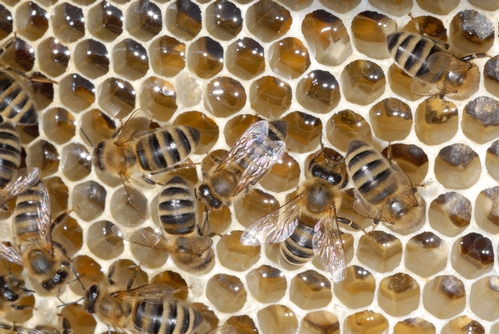

- Author: Kathy Keatley Garvey
The Berkeley City Council did the right thing.
The council members voted this week to landscape city parks and open spaces with pollinator-friendly plants.
The plan: to provide a friendly habitat and food source for pollinators, especially honey bees.
Within the next few weeks, the park staff will plant native, flowering plants. They'll take precautions by placing the plants at least 30 feet from children's play areas, garbage cans and restrooms.
Bee behavior being what it is, a single bee nectaring a flower isn't likely to sting. Or, for that matter, many bees visiting flowers. The bees are there to work: to gather nectar and pollen for their colonies.
The bee garden follows on the heels of the newly announced vegetable and herb garden at the White House. That, too, is an important food source for pollinators.
One of the best comments we've heard:
"The First Family has set a great example for Americans," said Ching-Yee Hu, Haagen-Dazs brand manager in a recently published news release. "It not only shows everyone the importance of backyard gardens and knowing how food gets to your table, but also lets everyone know that bees are important and they need our help."
That bears repeating: "...bees are important and they need our help."
As part of its public service, Haagen-Dazs launched a nationwide campaign last year to help save the bees, including helping research efforts at UC Davis and Pennyslvania State. This year is Year 2 of the campaign. Their projects include funding a honey bee haven, or bee friendly garden, at the Harry H. Laidlaw Jr. Honey Bee Research Facility at UC Davis. Nearly 50 percent of Haagen-Dazs ice cream flavors depend on honey bees, or as they put it, are "bee-built."
Among the company's other bee friendly plans: to distribute two million flower seeds this year. Some will be given away at the UC Davis Picnic Day on Saturday, April 18. The display will be at Briggs Hall, as part of the UC Davis Department of Entomology's Picnic Day celebration. Meanwhile, you can ask for free seeds by e-mailing hdloveshb@gmail.com. (The hdloveshb means "Haagen-Dazs Loves Honey Bees.") More information appears on their educational site, helpthehoneybees.com.
It's nice to see the united effort by the nation, states, cities, businesses, and residents to support the honey bees.
Sunny days ahead!



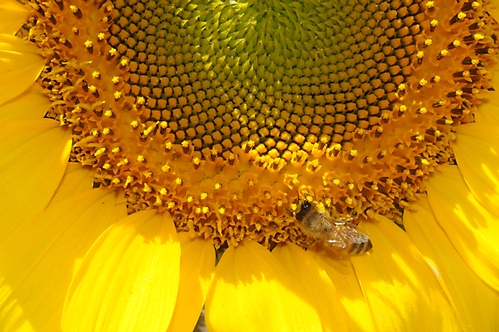
- Author: Kathy Keatley Garvey
There are so many caring, kindhearted and generous people out there concerned about the plight of the honey bee.
From little girls who share their monthly allowance and birthday gifts, to all the schools, organizations and businesses who donate to the honey bee research fund at the Department of Entomology at the University of California, Davis, the cry to "Save the Honey Bees" is resounding throughout the world.
In particular, the response to the Häagen-Dazs' educational Web site, www.helpthehoneybees.com has been overwhelming.
Häagen-Dazs stepped forward in February of 2008 to help save the honey bees. They launched a national campaign, established a scientific advisory group, created the Web site and a new Vanilla Honey Bee flavor, and donated a total of $250,000 toward honey bee research at UC Davis and Pennsylvania State. They're also working to help fund a honey bee haven at UC Davis.
Approximately 50 percent of the Häagen-Dazs flavors are directly attributed to honey bee pollination. In fact, one-third of all we eat (fruits, vegetables and nuts) is pollinated by bees.
The declining bee population worries us all.
Enter California poet Michele Krueger. While enjoying a pint of Häagen-Dazs ice cream and accessing the Häagen-Dazs Web site, she was inspired to write a poem about honey bees. She donated the poem to the UC Davis Department of Entomology.
In her email, Krueger wrote: "I am a poet from Northern California (Lake County) and concerned about the bee crisis, too."
We thank her for her concern and her donation. Here is her poem:
Appreciation
Be the best you can be,
Honeybee.
For me.
Please pollinate
my berries,
sip nectar from
my flowers,
so you will have
the strength to fly
back and forth
for hours.
You have work to do,
Worker Bee,
for fruit tree
and for me.
Servant of Queen,
Feeder of Drone,
Soldier of Hive,
Miner of Gold,
I award you
Employee of the Season.
Honey is my reason.
Every year.

- Author: Kathy Keatley Garvey
It blooms in winter and the bees love it.
Winter jasmine (Jasminum nudiflorum), a rambling vine with trumpetlike yellow flowers, is charming visitors in the Storer Gardens at the University of California, Davis. The plant originates from western China.
The six-petaled blossoms gleam like gold in the wintry garden. When the pelting rain strikes them, they look like delighted kindergarteners splashing around in yellow raincoats.
Don't be surprised to see winter jasmine among the selections in the half-acre bee friendly garden being planned at the Harry H. Laidlaw Jr. Honey Bee Research Facility at UC Davis. The nationwide landscape design competition, which ends Jan. 30, is sponsored by Häagen-Dazs. The garden is expected to be a reality by October.
Unfortunately, the winter jasmine has no fragrance. But that doesn't stop the bees from greeting and hugging the flowers and gathering pollen. It would take the long beak of a hummingbird to reach into the trumpetlike flower for the nectar. Or a carpenter bee to slit the corolla and steal the nectar.
But for now, on the afternoon of Jan. 24, 2009, the moments are golden.



